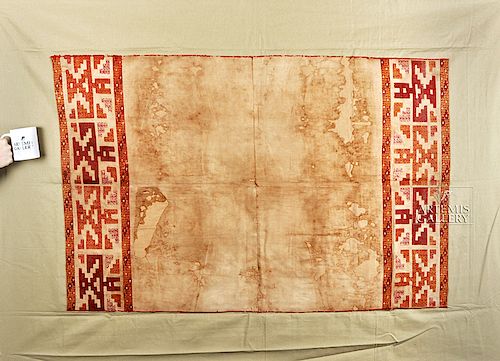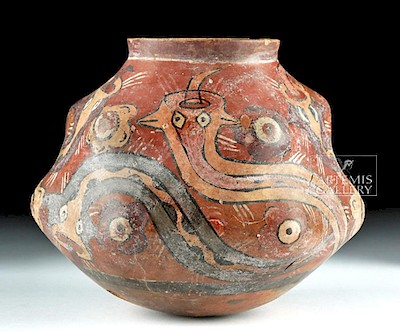Large Pre-Columbian Pachacamac Textile Panel
Lot 162
About Seller
Artemis Fine Arts
686 S Taylor Ave, Ste 106
Louisville, CO 80027
United States
Selling antiquities, ancient and ethnographic art online since 1993, Artemis Gallery specializes in Classical Antiquities (Egyptian, Greek, Roman, Near Eastern), Asian, Pre-Columbian, African / Tribal / Oceanographic art. Our extensive inventory includes pottery, stone, metal, wood, glass and textil...Read more
Estimate:
$1,800 - $2,700
Absentee vs Live bid
Two ways to bid:
- Leave a max absentee bid and the platform will bid on your behalf up to your maximum bid during the live auction.
- Bid live during the auction and your bids will be submitted real-time to the auctioneer.
Bid Increments
| Price | Bid Increment |
|---|---|
| $0 | $25 |
| $300 | $50 |
| $1,000 | $100 |
| $2,000 | $250 |
| $5,000 | $500 |
| $10,000 | $1,000 |
| $20,000 | $2,500 |
| $50,000 | $5,000 |
| $100,000 | $10,000 |
| $200,000 | $20,000 |
About Auction
By Artemis Fine Arts
Jul 5, 2018
Set Reminder
2018-07-05 10:00:00
2018-07-05 10:00:00
America/New_York
Bidsquare
Bidsquare : Ancient | Ethnographic | Fine Art
https://www.bidsquare.com/auctions/artemis-gallery/ancient-ethnographic-fine-art-3306
Featuring classical antiquities, ancient and ethnographic art from cultures encompassing the globe. Artemis Fine Arts info@artemisfinearts.com
Featuring classical antiquities, ancient and ethnographic art from cultures encompassing the globe. Artemis Fine Arts info@artemisfinearts.com
- Lot Description
Pre-Columbian, Peru, Lurin Valley, Pachacamac, ca. 11th to 16th century CE. A finely woven textile comprised of camelid (alpaca or llama) fibers of red, yellow, umber, and white hues on a beige fabric ground (four joined panels). The design/iconographic program features two wide registers that when viewed sideways appear to include four large anthropomorphic forms with bodies comprised of stepped motifs and presenting profile heads with single eyes. These are surrounded by narrow borders comprised of abstract zoomorphic faces in profile as well. The central section is nicely demarcated by a narrow red and gold border. Size: textile measures 49.5" W x 32.5" H (125.7 cm x 82.6 cm); 66.5" W x 48" H (168.9 cm x 121.9 cm) including beige cotton fabric backing
Pachacamac is located on the Peruvian coast approximately 32 kilometers south of Lima. It was a sacred site, as well as an oracle, and place of burial, that pilgrims from numerous ancient Andean cultures visited, including the Incas. Active for more than 2,000 years, this site was named after the god Pacha Kamaq who was worshipped as the "Maker of the Earth" by these coastal peoples and was also associated with powerful earthquakes. According to indigenous mythology, Pachacamac had defeated Con, the rival creator god who as a form of punishment for humankind's evilness had stopped all rainfall. Pachacamac resorted to transforming the human race into animals and subsequently created an entirely new race of men and women. Some versions of the myth tell of the god sending four stars to earth. Two of the stars were male and became kings and nobility. The other two stars were female and became common folk.
Provenance: private Hawaii, USA collection
All items legal to buy/sell under U.S. Statute covering cultural patrimony Code 2600, CHAPTER 14, and are guaranteed to be as described or your money back.
A Certificate of Authenticity will accompany all winning bids.
We ship worldwide and handle all shipping in-house for your convenience.
#132061Staining as shown. Areas of loss and repair, particularly to the central plain section, though there are a few very small losses to the border panels.Condition
- Shipping Info
-
All shipping is handled in-house for your convenience. Your invoice from Artemis Gallery will include shipping calculation instructions. If in doubt, please inquire BEFORE bidding for estimated shipping costs for individual items.
-
- Buyer's Premium



 EUR
EUR CAD
CAD AUD
AUD GBP
GBP MXN
MXN HKD
HKD CNY
CNY MYR
MYR SEK
SEK SGD
SGD CHF
CHF THB
THB














